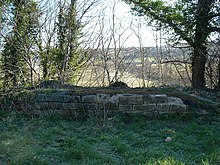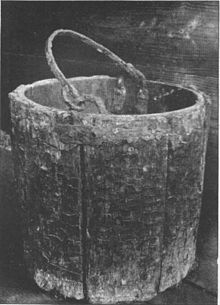Duffield Castle (Derbyshire)
Duffield Castle was a Norman castle in the village of Duffield in the English county of Derbyshire . The property is a Scheduled Monument .
The castle stood on a rocky promontory over the river, which was easy to defend, but it is debatable whether this area was inhabited in prehistoric times. It is also not known for sure whether the Romans had a military fortress there to protect the nearby ford, via which the lead convoy reached the North Sea ports on Rykneld Street near Derventio (now part of Derby ) on their way from Lutudarum (probably Wirksworth ) to the North Sea ports .
However, remains were found that seem to come from the Anglo-Saxon period , which suggests the settlement by people in an elevated position, probably an Anglo-Saxon Thane named Siward or his relatives. Also a considerable number of Roman clay artifacts, e.g. B. Roman type roof tiles have been found. Some of the artifacts are in the Derby Museum today , others remain in the meetinghouse, many have been lost.
Norman castle
What we do know, however, is that around 1066 Henry de Ferrers (or Ferrars ) was given lands in Derbyshire called Duffield Frith as a fief for his great services to King William the Conqueror . They stretched from Heage and Shottle in the north to Tutbury in the south. The landlord had Tutbury Castle built and made the castle his headquarters, but he also needed an outpost to protect his lands further north and thus had another castle built, presumably made of wood, in Duffield.
His third son, Robert , proved himself in the 1138 standard battle against the Scots and was named Earl of Derby .
His great-grandson, William , who moved up to this position in 1162, joined the king's son in a rebellion against his father, Henry II , and in 1173 both castles were destroyed.
He was followed by his second son, William , favorite of King John Ohneland , who reinstated the Earldom with the manors of Wirksworth, Ashbourne and later Horsten Castle . At the same time the castles of Duffield and Tutbury were rebuilt, this time in stone. The next William also enjoyed the king's goodwill.
The next earl, Robert , the 7th generation, rebelled against King Henry III. and Tutbury Castle was destroyed. Although pardoned, Robert rebelled again, was defeated at the Battle of Chesterfield , lost his possessions in 1269 and Duffield Castle was destroyed. His lands were given as a fief to Prince Edmund , who was later made Earl of Lancaster .
The castle was literally shaved to the ground, with many of its bricks being swept away for other buildings. The place of the former castle was slowly overgrown with plants. Memories of a castle have been preserved and can be found in the name "Castle Orchard", a grove that stretched from today's farms of the same name down on Castle Hill to Hazelwood Road. The property was rediscovered in 1885.
Excavations
When the property was being archaeologically worked, the foundations of a traditional Norman moth with a stone donjon were found. Noteworthy was the size of the latter, about 29 meters long and 28.5 meters wide, only a little smaller than the White Tower in London .
The property was secured, the foundations marked and in 1899 handed over to the National Trust , one of its first archaeological monuments. For many years the maintenance work was carried out by the local government, but recently it has been taken over by the trust.
Although further excavations were carried out in the 1930s and 1957, few medieval remains were found, but the theory that the site was inhabited before the Normans arrived has been corroborated by a number of finds from Roman times.
A geophysical survey of the property was carried out by the University of Bradford in 2001 and revealed traces of other buildings south and southeast of the castle that appeared to be from the same period. The National Trust is currently trying to raise funds to conduct further investigations.
In addition, the de Ferrers family presided over an important iron-making center in Normandy . This is said to be the origin of the nail smithy in Belper .
Individual evidence
- ^ TG Manby: Duffield Castle Excavations 1957 . Issue 79, DAJ, 1959.
- ^ William Bland: Recent excavations and discoveries on Castle Hill . January 11, 1887. Retrieved November 20, 2015.
- ^ JC Cox: Duffield Castle; its history, site, and recently found remains; with some account of the seven Earl Ferrers who held it. great. tab. Derbyshire Archaeological Journal. Issue 9 (1887).
- ↑ National Trust Annual Archaeological Review 2001–2002 .
Web links
Coordinates: 52 ° 59 ′ 34.1 ″ N , 1 ° 29 ′ 22.9 ″ W.



